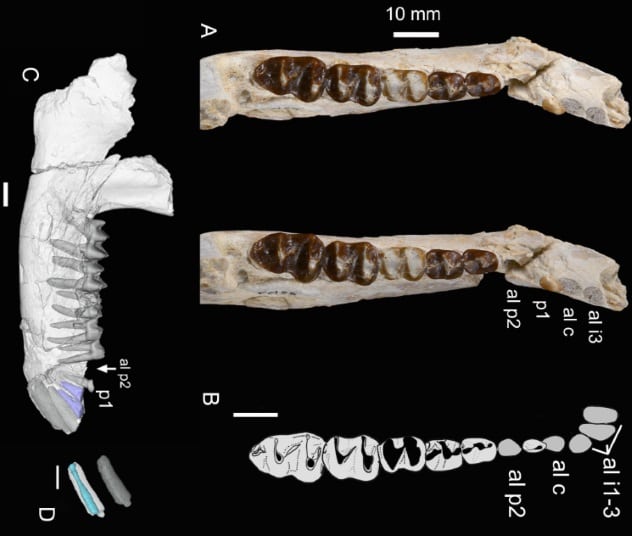 Weird Stuff
Weird Stuff  Weird Stuff
Weird Stuff  Our World
Our World 10 Ways Your Christmas Tree Is More Lit Than You Think
 Movies and TV
Movies and TV The 10 Coolest Stars to Set Sail on The Love Boat
 History
History 10 Things You Didn’t Know About the American National Anthem
 Technology
Technology Top 10 Everyday Tech Buzzwords That Hide a Darker Past
 Humans
Humans 10 Everyday Human Behaviors That Are Actually Survival Instincts
 Animals
Animals 10 Animals That Humiliated and Harmed Historical Leaders
 History
History 10 Most Influential Protests in Modern History
 Creepy
Creepy 10 More Representations of Death from Myth, Legend, and Folktale
 Technology
Technology 10 Scientific Breakthroughs of 2025 That’ll Change Everything
 Weird Stuff
Weird Stuff Ten Bizarre Facts About The Doge Meme
 Our World
Our World 10 Ways Your Christmas Tree Is More Lit Than You Think
 Movies and TV
Movies and TV The 10 Coolest Stars to Set Sail on The Love Boat
Who's Behind Listverse?

Jamie Frater
Head Editor
Jamie founded Listverse due to an insatiable desire to share fascinating, obscure, and bizarre facts. He has been a guest speaker on numerous national radio and television stations and is a five time published author.
More About Us History
History 10 Things You Didn’t Know About the American National Anthem
 Technology
Technology Top 10 Everyday Tech Buzzwords That Hide a Darker Past
 Humans
Humans 10 Everyday Human Behaviors That Are Actually Survival Instincts
 Animals
Animals 10 Animals That Humiliated and Harmed Historical Leaders
 History
History 10 Most Influential Protests in Modern History
 Creepy
Creepy 10 More Representations of Death from Myth, Legend, and Folktale
 Technology
Technology 10 Scientific Breakthroughs of 2025 That’ll Change Everything
10 Mysteries And Conundrums That Were Recently Put To Bed
The bewildering world around us got a little less bewildering recently. So far, 2018 has been a good year for solving mysteries that had haunted us for decades, centuries, and even millennia. More and more of the unknown becomes known with each passing day.
There is still so much more left to discover. For now, though, we learn a few answers regarding mysteries involving ancient civilizations, vanishings, secret codes, our planet, and the universe around us.
10 Who Was Joseph Chandler?

Back in 2002, a 76-year-old man named Joseph Chandler who was living in Eastlake, Ohio, committed suicide. Sad, but straightforward. At least, that’s what authorities thought at first. When they tried to locate his family, they discovered that the deceased was not the real Joseph Newton Chandler III. In fact, the real one died in 1945, when he was just eight years old.
This mystery lasted for 16 years until June 2018, when officials revealed the man to be Robert Ivan Nichols.[1] Through genealogical research and DNA testing, investigators tracked down his son and obtained his identity.
Robert Nichols was a decorated World War II Navy veteran. After the war, he had a seemingly normal life with a wife and three kids and a job working as a draftsman for General Electric. In 1964, Nichols abruptly left his family, saying only that they would know why “in due time.” In 1978, he became Joseph Chandler, obtaining a birth certificate, social security card, and a job under that identity. What he did during the prior 14 years remains shrouded in secrecy.
The people who knew the man as Joseph Chandler described him as an eccentric, highly intelligent loner. He kept a packed suitcase ready to go and would sometimes disappear for days or weeks at a time. Authorities are still trying to piece together his past but consider it likely that Nichols had a sinister reason to run. One popular hypothesis presents him as the Zodiac Killer.
9 What Did The Spanish King Say To His General?

King Ferdinand II of Aragon was one of the most important leaders in Spanish history. He played a pivotal role in the Reconquista. His marriage to Queen Isabella I laid the foundation for the Spanish monarchy, and, together, they also sponsored the first voyage of Christopher Columbus. And Spain’s intelligence service recently managed to decipher a 500-year-old secret code that Ferdinand used to communicate with his general.
The code was used in letters between the king and General Gonzalo de Cordoba during Spain’s war with France over the Kingdom of Naples. It took roughly 15 days for documents to travel between parties, so the cipher was a precautionary measure should they fall into enemy hands.
The code consisted of 237 combined letters and 88 distinct symbols. Each real letter was constructed from two to six of these characters, and they were all written without any separation between words and phrases.[2] It puzzled historians for centuries. After the documents went on display at the Army Museum in Toledo, they asked for professional help. Expert codebreakers from the National Intelligence Center (CNI) were brought in to crack the system. They managed to decipher four letters after six months of work, and historians are hopeful the rest will eventually be translated in the future.
8 Why Is Tracy Melting Fast?

Here’s a mystery from Greenland. There are two adjoining glaciers called Tracy and Heilprin flowing into the Inglefield Gulf. Even though they are side by side, one of them is losing ice almost four times faster than the other one.
Humans have been observing the two glaciers sporadically for 120 years. In that time, even though they are seemingly subjected to the same conditions, Tracy has retreated upstream for over 15 kilometers (9.5 mi), while Heilprin only retreated 4 kilometers (2.5 mi). What could be causing the disparity?
We now have the answer, courtesy of NASA’s Oceans Melting Greenland (OMG) campaign. It was conceived in 2015 specifically to monitor ice loss from Greenland’s glaciers. Ocean data gathered by NASA showed that a plume of warm water flows under Tracy, while a much colder one can be found in front of Heilprin.[3]
Another major difference is that Tracy extends much deeper below the ocean surface—about 600 meters (2,000 ft) as opposed to Heilprin’s 350 meters (1,100 ft). The top ocean layer around Greenland is actually colder than the deep water 200 meters (660 ft) and below, which travels through currents from down south. A deeper glacier like Tracy is, therefore, exposed to more warm water than its shallower neighbor, which also affects melting rates.
7 What Happened To Louise Pietrewicz?

It has been 51 years since Louise Pietrewicz disappeared without a trace from a farming community in Long Island. Now, finally, we have found her remains and, perhaps, might even be able to piece together her final days.
The story was that 38-year-old Louise ran away with her then-boyfriend, police officer William Boken. Trapped in an abusive marriage, she emptied her savings account, he quit his job, and the two vanished together. The tale was convincing enough that nobody was ever arrested in connection with her disappearance, and the case was mostly forgotten.
A renewed interest in the case was brought on late last year by an in-depth investigation published by the Suffolk Times. The extra attention convinced a woman to come forward and bring the mystery to a close. She was William Boken’s ex-wife, and she claimed that he buried a body underneath the basement of their old home in Southold, New York.
She was right. Using ground-penetrating radar, police found skeletal remains in a burlap bag.[4] A medical examiner managed to obtain a DNA sample and positively matched it to Louise’s daughter. Later analysis showed that Louise had been shot, most likely by Boken, who died in 1982. No details were given about how his wife found out about the body or why she didn’t come forward until now.
6 Where Did The Embrithopods Come From?

The recent discovery of the oldest fossils belonging to an extinct group of animals called Embrithopoda has helped to solve the mystery behind its origins.
The extinction of the dinosaurs created a power vacuum which was quickly filled by large mammals that became the dominant land animals. One such group was Embrithopoda, an order of creatures related to elephants. The most well-known embrithopod was Arsinoitherium, a massive, rhino-like creature with two giant horns above its nose.
A new development occurred at a dig in a Moroccan quarry. Paleontologists found 55-million-year-old fossils belonging to a new embrithopod genus named Stylolophus.[5] This seemingly puts to bed a debate over whether the order originated in Africa or the Middle East. Previously, the oldest-known fossils were 48 million years old and were found both in Northern Africa and Turkey.
Based on this new discovery, some paleontologists have lobbied to reclassify embrithopods as part of the larger Afrotheria group. This clade contains mammals of African origin, including extant species such as elephants, tenrecs, sea cows, aardvarks, and hyraxes.
5 Who Was Lyle Stevik?

In 2001, a young man in his twenties checked into a motel in Amanda Park, Washington, under the name Lyle Stevik. He hanged himself, and his body was found a couple of days later. Subsequent efforts by authorities to identify him failed, and it seemed like Lyle Stevik was condemned to remain an enigma.
His story resonated with the online community, and his case became well-known among amateur Internet sleuths. Numerous hypotheses were put forward regarding his possible background or motive. Stevik killed himself a few days after 9/11, so many speculated that the two were somehow connected. Some believed he was a hijacker who backed out at the last minute or perhaps a planner who was consumed with guilt. He could have also been a spy or a cult member. As long as there was no solid evidence to solve the mystery, people let their imaginations run wild.
In May 2018, Lyle Stevik was identified by the DNA Doe Project, a nonprofit organization that tries to solve cases with unidentified persons.[6] They used a genealogy database, a technique that has been in the spotlight a lot recently.
Police have not released Stevik’s real name to protect his family’s privacy. His story was more tragically banal than people envisioned. He wasn’t a terrorist or a spy. He was just a troubled youth who ran away from home.
4 Why Is The Great Pyramid Lopsided?

The Egyptian pyramids are a marvel of the ancient world. They are so advanced that many people believe such engineering feats could have only been accomplished by alien civilizations. As it turns out, the Great Pyramid of Giza isn’t as flawless as you would expect. The west side is actually longer than the east, making it lopsided. This was probably due to a tiny construction error made 4,500 years ago.
Surprisingly, despite all the time we spent studying the Great Pyramid, this discovery wasn’t made until 2016. Teams from the Ancient Egypt Research Associates (AERA) and the Glen Dash Research Foundation were conducting a survey to determine how the ancient engineers laid out the base of the pyramid. For this, they needed to trace the outline of the base as it was thousands of years ago.
This was tricky because, originally, the pyramid was encased in an outer layer of white limestone, stripped away a long time ago. Researchers looked for markings to find out where these stones used to sit. They found 84 points, which they used to determine the original edges. They used a technique called linear regression to calculate the lengths. The sides were approximately 230.295 to 230.373 meters (755.561–755.817 ft), but the west side was 230.378 to 230.436 meters (755.833–756.024 ft).[7] It was a simple mistake but enough to make the pyramid a little wonky. The Great Pyramid is still impressive, but you would expect better from hyper-advanced extraterrestrials.
3 What Killed The Unluckiest Man In Pompeii?

A few months ago, archaeologists excavating the ancient Roman city of Pompeii announced the discovery of a new skeleton. He was particularly notable for his Looney Tunes-esque demise, which saw a giant 270-kilogram (595 lb) stone block land on the upper half of his body, seemingly decapitating him. The image of the doomed fellow soon became viral online, where he was deemed “the unluckiest man in the world.”
As it turns out, he might not have been any more or less lucky than the thousands of other people who died when Vesuvius erupted almost 2,000 years ago. Archaeologists found the missing parts of the body intact.[8] They changed his cause of death from “crushed by flying projectile” to “asphyxiation caused by the pyroclastic flow.”
The skeleton was sitting on top of a Bourbon-era tunnel. It caved in at a certain point in time, causing his skull, thorax, and upper limbs to fall away. They were found about 1 meter (3.3 ft) below the rest of the body. Barring a few fractures, the skull was intact and even had most of its teeth. It certainly wasn’t crushed by a giant boulder. While the mystery surrounding the man’s death seems cleared up, researchers are still keen to determine how his skeleton ended up in its peculiar final position. They believe the stone block might have been a doorjamb but are unsure when it fell over the body.
2 What Causes The Lightning Of Jupiter?

People have theorized for hundreds of years that Jupiter has lightning, but it wasn’t until 1979, when Voyager 1 flew by the gas giant, that we had official confirmation. Since then, we’ve been left with many questions, but some of them were answered thanks to Juno.
For 39 years, we believed that Jupiter’s lightning was different from Earth’s because it only registered on the kilohertz range of the radio spectrum. Juno‘s Microwave Radiometer (MWR) detected 377 lightning discharges, and they were in the megahertz and gigahertz range like we would find on Earth. This showed that the mystery was caused by our previously insufficient technology, not a Jovian phenomenon.
That being said, they are not identical. JPL scientist Shannon Brown described Jupiter’s lightning distribution as “inside-out relative to Earth.”[9] Jupiter has a lot of lightning activity at the poles and none at the equator. The reverse is, more or less, true for our planet.
Scientists believe this is due to how each planet is heated. We get most of our heat from the Sun. The equator is much hotter than the poles, and it has more warm, moist air to rise and generate lightning. Jupiter, however, receives 25 times less sunlight. In fact, it receives just enough heat at its equator to create a stable atmosphere and prevent any warm air from rising. This isn’t the case at the poles, which is why they still have powerful lightning storms.
1 When Did Our Testicles Descend?

A study recently published in PLOS Biology attempts to unravel the origins of descended testicles. Did early mammals have this curious trait, or did we gain it along the way?
Today, animals belonging to the aforementioned group Afrotheria have the trait known as “testicondy,” which means that their testicles remain inside their abdomen. However, is this simply an evolutionary quirk or a remnant of our ancient mammalian ancestors?
Like all soft tissue, testes make for poor fossils, so there’s no physical evidence to analyze. However, a team of genomicists from the Max Planck Institute of Molecular Cell Biology and Genetics in Dresden, Germany, looked at the problem from a genetic perspective.
We have previously identified two genes, INSL3 and RXFP2, which are responsible for the downward migration of testicles prior to birth. The scientists looked at the genomes of 71 mammals. Four Afrotherian species with testicondy still carried defunct copies of these genes.[10]
Moreover, researchers were able to approximate when the loss of the genes occurred by counting the number of mutations in their gene sequences. They happened between 23 and 83 million years ago. The Afrotherian lineage diverged about 100 million years ago, which means the first Afrotherians had descended testes. They concluded that the early mammals also had this physical trait, and Afrotherians independently evolved undescended testicles on four separate occasions.
Read about more mysteries that have been solved on Top 10 Murder Mysteries Finally Solved Using Forensics and 10 Unsolved Mysteries That Have Finally Been Cracked.








